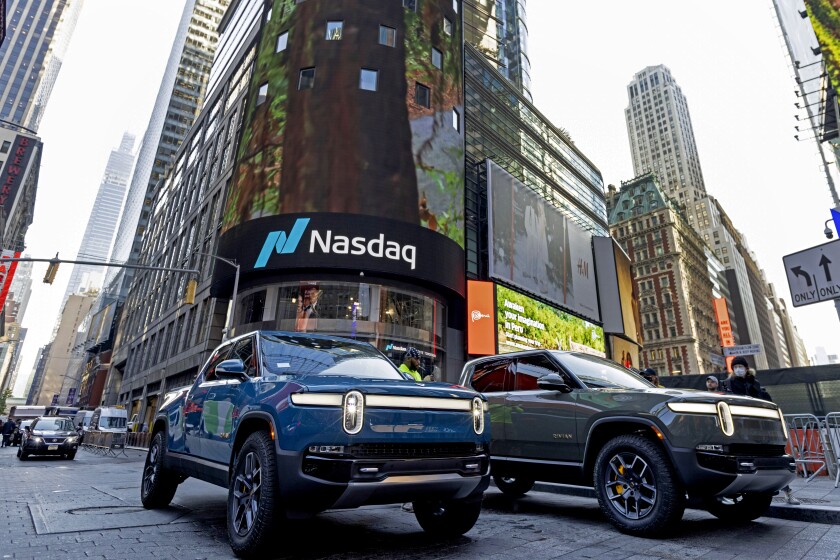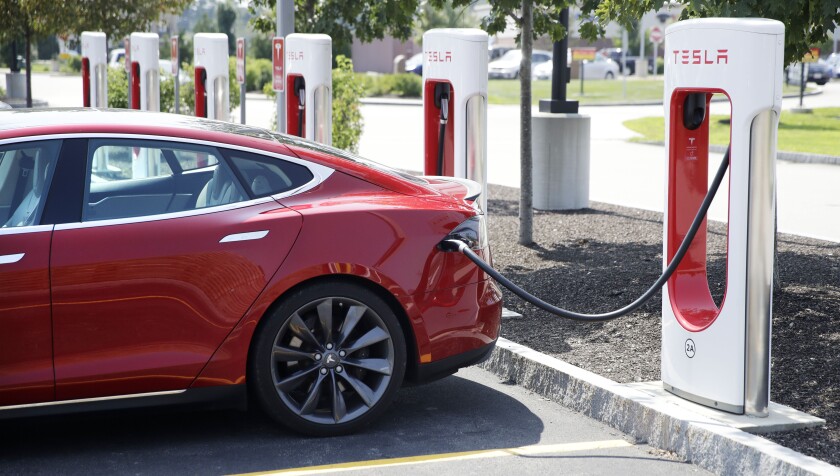Dennis Wang lost money on his first try, but then he learned from his mistakes.
On his second effort as an electric vehicle flipper, Wang made $4,000. On his third, he hit what he considered the sweet spot, a $7,000 profit. All the deals involved Teslas that Wang bought and resold, flipping them like tickets to a hot concert.
“I have a Model S currently that I’m probably going to sell within another three months, pending the market,” Wang said. “I also have another Model Y and a Model X on order.”
Buying and reselling stuff is as old as commerce itself, complete with cautionary tales and questionable legality. House flipping has become so alluring that multiple reality TV shows hype the process and personalities involved.
Now a new breed of flipper has emerged hoping zero emissions equal big profits. Helping them is an unusual confluence of factors plaguing EV manufacturers (supply chain problems, semiconductor shortages, unmet production goals, an emerging scarcity of lithium batteries) as well as car shoppers (record fuel prices, high used car prices, long waiting lists for electric vehicles).
Some like Wang, a 33-year-old automotive buff with mad spreadsheet skills, have learned that they can flip cars, with a recent emphasis on electric vehicles. Some EV flippers are finding buyers willing to pay sometimes exorbitant sums, tens of thousands more than the retail price, to acquire the vehicles.
Consider the person trying to sell a practically new 2022 Hummer EV1 for $220,000 on Facebook. It had been retailing for less than half of that, at $105,000.
Also on Facebook are two 2022 Rivian R1T electric adventure vehicles listed for $123,000 and $220,000. On the Rivian website, the same vehicle starts at $67,500. Buyers on Cars & Bids, an online auction site, could find them listed for $97,000 and $103,000. Although the more outrageous asks for double to triple the value of some EVs are either ignored or severely flamed online, some less lofty listings are having success.
Cars & Bids, for example, lists 14 recent sales of the R1T, between April 12 and June 28, for prices that ranged from $106,000 to $138,000.
A Tesla Model S is plugged in at a vehicle Supercharging station in Seabrook, N.H., in 2018.
(Charles Krupa / Associated Press)
In June, Tesla raised the price of its Model Y by 5%, to $65,990, but that hasn’t stopped the flippers. A Model Y with less than 2,800 miles was recently up for sale on Edmunds for $70,995. Edmunds considered that a “good price,” at $1,739 “below market,” as in what the market says such a car is worth.
Eddie Gribust, who makes a living outfitting Mercedes-Benz Sprinter vans for off-grid use, recently unloaded the Tesla Model Y he’d used as the family car for nine months.
Gribust was so excited about the sale — the buyer flew from Las Vegas to Boise, Idaho, for the transaction — that he posted a YouTube video titled: “Flipping my Tesla for $5,000 profit! Here’s How.”
“Since my business is buying and selling these Sprinters, I’m aware of things like the microchip shortage,” Gribust said. “And everybody has been talking about how the secondary market especially has grown 20 to 30%.
“I was about to order a [Tesla] Model X and the Cyber Truck. The delivery times were nine months to a year, and that would obviously signal high demand, and therefore, low supply. From there, it was taking advantage of simple economics.”
Former Securities and Exchange Commission Chief Economist Larry Harris teaches that exact lesson to students at USC’s Marshall School of Business.
“When supply and demand are not in alignment, you get these opportunities where clever people can take advantage,” Harris said. “We’ve seen this in all kinds of markets. When prices change significantly for scarce goods, some buyers realize that the item has a greater value to others than it does to them, and they will sell to the people willing to pay more than they would, and profit from it.”

A Rivian R1T all-electric truck in New York’s Times Square in 2021.
(Ann-Sophie Fjello-Jensen / Associated Press)
Or, as Gribust put it in his video, after expressing regret about giving up the Tesla, “I have a simple rule: If somebody places profit in your hand, all you have to do is close that hand and walk away.”
Recurrent, which tracks the used EV market and provides car shoppers with independent reports on EV performance and battery life, noted in its most recent market evaluation that 2021 used EVs “make up a surprising 17.5% of inventory.”
The Seattle startup found that used EVs had climbed 25% in price since March 2021. On average, it said, a 2021 Mustang Mach E was selling for 60% more than it was last year. Citing what it called “the new normal, inflated prices are here to stay,” Recurrent said that the used EV sales trend was skewed heavily toward the most recent model years available.
“Anecdotally, we’ve heard of many owners who sold pretty new cars to dealers and made back more than their purchase price, and the numbers show this makes sense,” Recurrent said. “Reselling a barely-owned car works differently for different cars. In terms of Teslas, the price of new vehicles increased so much last year, and waiting periods are so long for new vehicles, that the value of used cars skyrocketed.”
If you’ve got a relatively new EV, Recurrent’s advice is to jump into the game now.
“If you are an EV owner or a dealer, now is as good a time as any to list a used EV. Since we speculate that prices will not change much in the coming months, by holding on to your car, you risk higher inventory flooding the market.”
If you’re one of the many hoping to obtain an EV, “it may not pay to wait for prices to come down,” Recurrent said.
The restrictions on flipping an EV depend on where you live.
In France, where flippers have been reselling nearly new EVs for a profit of $10,000 or more, the government in June changed its energy code to prevent the immediate resale for profit of electric vehicles purchased using state incentives. EV owners must now keep their cars for a year before reselling.
Germany has a six-month hold on reselling EVs but is considering an increase to a yearlong wait starting in 2023.
In the U.S., several states limit how many cars — EV or not — a person can buy and resell in a year before needing a vehicle dealer license, which in California requires taking an online course, passing a DMV-administered test, paying fees and meeting other requirements. The states are trying to protect consumers from car thieves and unscrupulous sellers and protect auto dealers from street-level competition.
If you are selling a car for profit in California, for example, you have to have a retail car seller’s license, said the California DMV’s occupational licensing office, even if you are using an auto selling auction site as an intermediary.
In California, obtaining such a license requires a six-hour course, passing a test and paying fees. Most EV flippers can’t do high-volume sales anyway because it takes too long to get the cars in the first place. In terms of enforcement, according to California DMV investigations offices, the agency’s main targets are those running volume sales without a license or a car-selling lot. Still, it will pay — no pun intended — to play by the rules; breaking them can result in fines and possible imprisonment, based on the severity of the case.
Los Angeles resident Wang, a digital marketing consultant for the automotive industry who said he is getting a license to sell, said he’s heard about several EV buyers on waiting lists already negotiating to sell them upon delivery. Some want an even quicker buck, he said.
“I’ve heard of some people transferring their reservation into your name for a price,” Wang said. “There’s ways to do it, but it’s like super hard.”
It’s also possible to aggravate the golden goose here. Wang recently posted a video on his YouTube channel citing examples of people who appeared to be banned from buying new Teslas because they were reselling them too soon and too often.
As far as cars are concerned, Wang is a love ‘em and leave ‘em kind of guy.
Although his recent focus is EVs, Wang has flipped several dozen cars over the years, at first buying them off Craigslist and doing minor upgrades before selling them. Of course, he remembers the first car he flipped — the car and the profit, exactly.
“It was a Lexus ES 300. I bought it for $3,000 and sold it for $4,000,” Wang said.
Wang insists he really doesn’t do it for the money; he just wants to drive as many cool cars as he can.
“Life is about experiences, right? I like cars. And so it just really fulfills my enjoyment of being able to drive a bunch of different kinds,” Wang said. “Before this, I used to work for BMW, and I had 20 BMWs at different times. So it’s the same thing I’m just doing with Tesla.”
Wang said his best customers are car dealers.
“I sold one to a private buyer, then I realized that dealerships would just cut you a check, and that’s even easier” than a private sale, Wang said.
His advice for would-be car flippers?
“Don’t pay for a lot of add-ons if it’s not a car you’re going to keep,” he said, “and don’t wait too long to sell it.”

